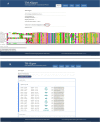TM-Aligner: Multiple sequence alignment tool for transmembrane proteins with reduced time and improved accuracy
- PMID: 28970546
- PMCID: PMC5624947
- DOI: 10.1038/s41598-017-13083-y
TM-Aligner: Multiple sequence alignment tool for transmembrane proteins with reduced time and improved accuracy
Abstract
Membrane proteins plays significant role in living cells. Transmembrane proteins are estimated to constitute approximately 30% of proteins at genomic scale. It has been a difficult task to develop specific alignment tools for transmembrane proteins due to limited number of experimentally validated protein structures. Alignment tools based on homology modeling provide fairly good result by recapitulating 70-80% residues in reference alignment provided all input sequences should have known template structures. However, homology modeling tools took substantial amount of time, thus aligning large numbers of sequences becomes computationally demanding. Here we present TM-Aligner, a new tool for transmembrane protein sequence alignment. TM-Aligner is based on Wu-Manber and dynamic string matching algorithm which has significantly improved its accuracy and speed of multiple sequence alignment. We compared TM-Aligner with prevailing other popular tools and performed benchmarking using three separate reference sets, BaliBASE3.0 reference set7 of alpha-helical transmembrane proteins, structure based alignment of transmembrane proteins from Pfam database and structure alignment from GPCRDB. Benchmarking against reference datasets indicated that TM-Aligner is more advanced method having least turnaround time with significant improvements over the most accurate methods such as PROMALS, MAFFT, TM-Coffee, Kalign, ClustalW, Muscle and PRALINE. TM-Aligner is freely available through http://lms.snu.edu.in/TM-Aligner/ .
Conflict of interest statement
The authors declare that they have no competing interests.
Figures



Similar articles
-
Kalign--an accurate and fast multiple sequence alignment algorithm.BMC Bioinformatics. 2005 Dec 12;6:298. doi: 10.1186/1471-2105-6-298. BMC Bioinformatics. 2005. PMID: 16343337 Free PMC article.
-
PSI/TM-Coffee: a web server for fast and accurate multiple sequence alignments of regular and transmembrane proteins using homology extension on reduced databases.Nucleic Acids Res. 2016 Jul 8;44(W1):W339-43. doi: 10.1093/nar/gkw300. Epub 2016 Apr 22. Nucleic Acids Res. 2016. PMID: 27106060 Free PMC article.
-
Accurate multiple sequence alignment of transmembrane proteins with PSI-Coffee.BMC Bioinformatics. 2012 Mar 28;13 Suppl 4(Suppl 4):S1. doi: 10.1186/1471-2105-13-S4-S1. BMC Bioinformatics. 2012. PMID: 22536955 Free PMC article.
-
PROMALS web server for accurate multiple protein sequence alignments.Nucleic Acids Res. 2007 Jul;35(Web Server issue):W649-52. doi: 10.1093/nar/gkm227. Epub 2007 Apr 22. Nucleic Acids Res. 2007. PMID: 17452345 Free PMC article.
-
PROMALS: towards accurate multiple sequence alignments of distantly related proteins.Bioinformatics. 2007 Apr 1;23(7):802-8. doi: 10.1093/bioinformatics/btm017. Epub 2007 Jan 31. Bioinformatics. 2007. PMID: 17267437
Cited by
-
Identification of potential key genes and pathways associated with the Pashmina fiber initiation using RNA-Seq and integrated bioinformatics analysis.Sci Rep. 2021 Jan 19;11(1):1766. doi: 10.1038/s41598-021-81471-6. Sci Rep. 2021. PMID: 33469142 Free PMC article.
-
Comparative transcriptome analysis reveals the genetic basis of coat color variation in Pashmina goat.Sci Rep. 2019 Apr 23;9(1):6361. doi: 10.1038/s41598-019-42676-y. Sci Rep. 2019. PMID: 31015528 Free PMC article.
-
Genome wide expression analysis of circular RNAs in mammary epithelial cells of cattle revealed difference in milk synthesis.PeerJ. 2022 Mar 1;10:e13029. doi: 10.7717/peerj.13029. eCollection 2022. PeerJ. 2022. PMID: 35251787 Free PMC article.
-
Refining pairwise sequence alignments of membrane proteins by the incorporation of anchors.PLoS One. 2021 Apr 30;16(4):e0239881. doi: 10.1371/journal.pone.0239881. eCollection 2021. PLoS One. 2021. PMID: 33930031 Free PMC article.
-
Adaptive Radiation of the Flukes of the Family Fasciolidae Inferred from Genome-Wide Comparisons of Key Species.Mol Biol Evol. 2020 Jan 1;37(1):84-99. doi: 10.1093/molbev/msz204. Mol Biol Evol. 2020. PMID: 31501870 Free PMC article.
References
-
- Alberts, B. et al. Molecular biology of the cell 4th edition: International student edition (2002).
Publication types
MeSH terms
Substances
LinkOut - more resources
Full Text Sources
Other Literature Sources

